Before I went to Sweden last summer, I received a lot of well-meaning advice from friends in Germany who had already been to Scandinavia:
“Take enough beer with you, it’s prohibitively expensive in Sweden!”
“As an EU citizen, you’re allowed to bring in 110 liters of beer and 90 liters of wine duty-free.”
“When we go to Scandinavia in the camper, we pour the liquid out of the pickle jars and replace it with alcohol. Okay, the vodka tastes like cucumbers, but so far, the customs inspectors never discovered it.”
“We fill the water tank in the camper with alcohol. After all, there are plenty of lakes to wash yourself in.”
“If you want to get drunk, take the ferry from Stockholm to Tallinn. Once you’re in international waters, you can drink duty-free.”
“Just take pure alcohol with you. You can dilute it and it will last you longer.”
I don’t care much for alcohol and filled the backpack with books instead. Scandinavian studies, Scandinavian history, Harry Martinson, all 10 volumes of the Inspector Beck novels by Maj Sjöwall and Per Wahlöö. There wouldn’t even have been room for one shot of Sherry.

Those among you who have not yet killed off all their brain cells with alcohol will be surprised: We already dealt with the role of alcohol in Scandinavia as part of this entertaining history series, didn’t we? That’s right, when I spoke about the Åland Islands. And we’ve already covered Sweden, haven’t we? Indeed, that one was about their attempt to create a better human being.
Today, I combine these two themes into a palatable mixed drink of alcohol and Scandinavian attempts at making the world a better place. We will talk about a referendum held on 27 August 1922, exactly 100 years ago, in which the Swedish people were to decide the fate of alcohol, once and for all.
But first – as happens when writing about history – we have to stagger back a bit along the timeline. The Scandinavians, as you know, are descended from the Vikings, who were drunk as a skunk at all times, whether on land, at sea or in Valhalla.
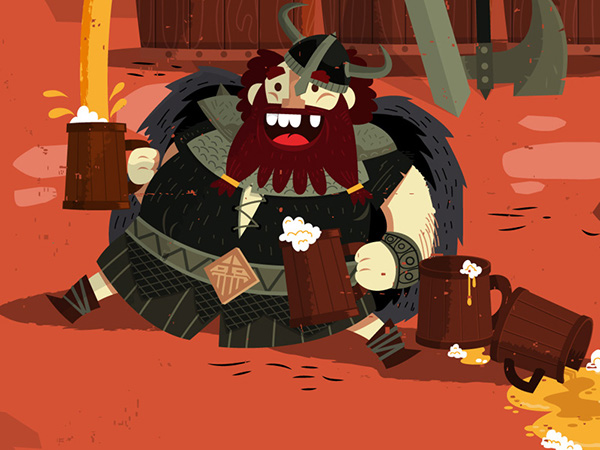
Even during their feared raids, they were so drunk that the well-known defense lawyer Hedobald Braxen got the Vikings acquitted on grounds of incapacity before the International Tribunal for the Law of the Sea. As a result, Sweden, Norway, Denmark and Iceland never had to pay reparations and are now in a pretty solid financial position. Unlike Haiti, which until 1950 was paying off debts for its revolution from 1791-1804 and for that gross injustice has to suffer the insult of constantly being referred to as “the poorest country in the western hemisphere”.
When industrialization took hold in Sweden in the 19th century (Volvo, Saab, Ericsson, Scania, etc.), factory owners found it convenient to pay workers with little money, but with plenty of brandy.
“We would actually prefer money,” a few recalcitrant trade unionists objected.
The factory owner lambasted them for their unpatriotic demands. “Remember, men: You are proud Vikings! They conquered the world for beer, not for some coins.”
The workers hung blue and yellow flags in their gardens and were henceforth very proud of their nation, but remained poor and drunk.

Nowadays, Swedes are very private and reserved, but back then there were still people who liked to stick their noses into other people’s business. No, I don’t mean the Säpo. I mean the temperance movement.
The teetotalers recognized the harmfulness of alcohol and, beginning in the 1830s, went around the country preaching to convince men (we’ll get to women later) to stop drinking, or at least to drink with temperance. Their motivation was partly health-related, partly religious and moralizing, but many of them wanted to create a better society. Which is why many teetotalers were found in the ranks of social democrats, Marxists, socialists, and communists. Because of their social-hygienic ideas, there was also an overlap with the eugenics movement of that time, which, as you already know, was very successful in Sweden.
Moreover, women found the teetotalers quite appealing, because they (and the children) had to suffer the most from their husbands beating them in a drunken stupor. And if the husband wasted half his wages on drinks on the way home from the factory, that wasn’t so good either.

The temperance movement was a mass phenomenon, a huge thing with millions of members, and no government could ignore their demands. Beginning in 1919, alcohol was rationed. Citizens received a ration book in which the alcohol already purchased was noted. Once the monthly limit was reached, you had to wait until the next month. (Or find a friend who didn’t drink and send him to the liquor store.)
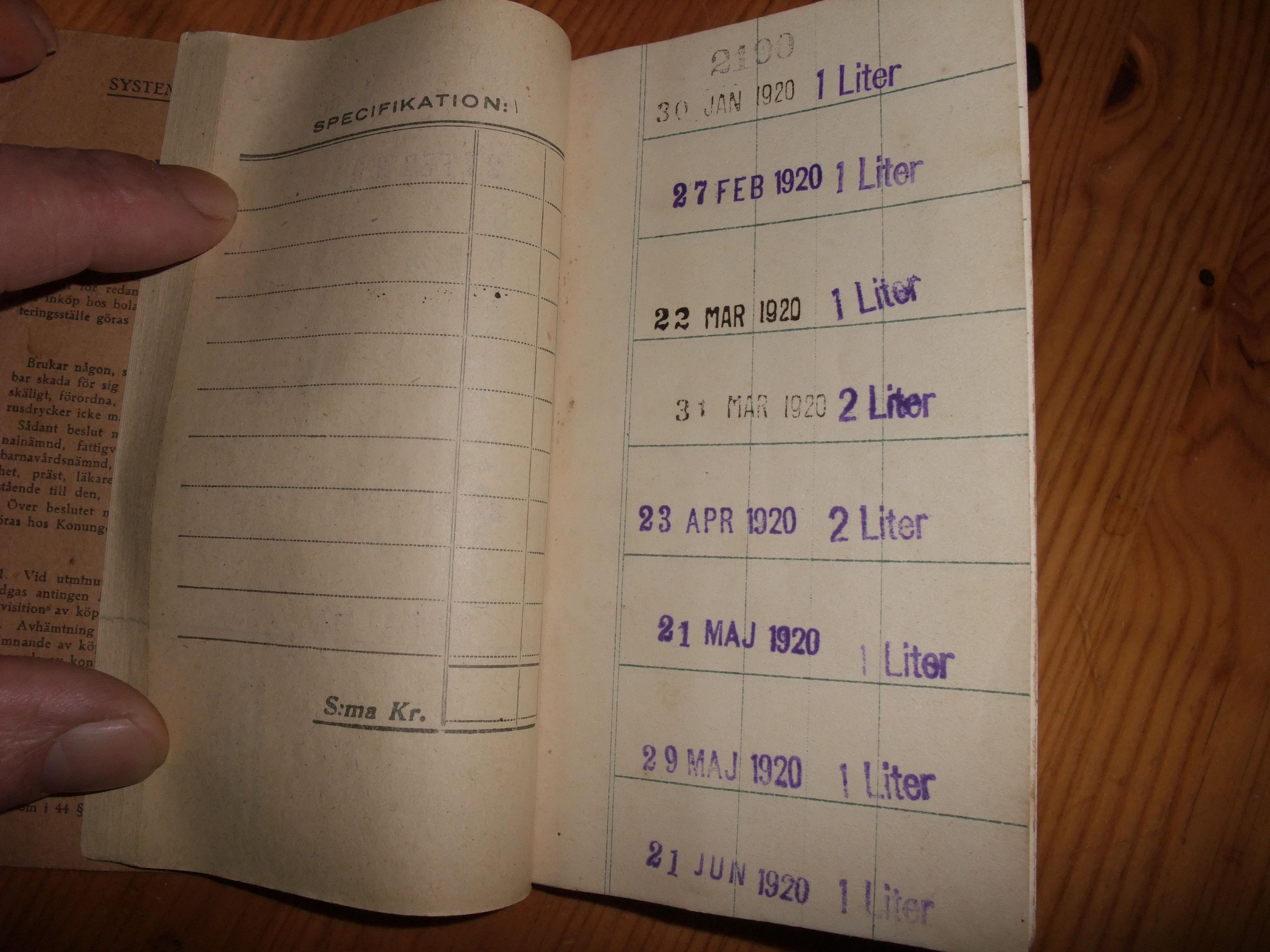
Now you probably want to know how much alcohol one was allowed to buy per month?
But it wasn’t that simple.
To get a ration book, you had to present yourself to the local sobriety committee. First, they checked whether you had already been noticed as an alcoholic, whether you had a regular job, whether your children went to school, whether you owed taxes, whether you kept your front yard clean, whether you were volunteering with the fire department, and so on and so forth.
Social status and class were also determining factors. The unemployed, homeless, and low-income people received no ration book at all. People in the countryside received a lower ration than people in urban areas (because people in the city have more social obligations at which alcohol is served). Those who had a profession in which you have to invite clients or customers for a drink (lawyers, notaries, real estate agents, film directors, trade and industry magnates, members of parliament, and probably the king) received a higher ration. Women received only a ration book as long as they were single. For weddings and birthdays, one could file a separate request for an extra ration.
And you know those people who claim that “corporations are people, too”? Well, now you can guess who came up with that idea.
Of course, the ration book could be withdrawn in the event of misconduct. The alcohol licensing authority had more information about its citizens than the Stasi, Securitate or Säpo.
Reading all of this is enough to make you want to stop drinking already, isn’t it?
But the Swedes continued to drink, and the teetotalers did not rest, not even on the seventh day. They did not want people to drink only 2 liters a month. They wanted that nobody never drank nothing no more. Not a single drop! Except maybe a cup of tea.

At the time, the idea of a complete ban on alcohol was not only on Swedish minds. Other countries had implemented it recently. Russia in 1914, Iceland in 1915, Norway in 1916, Finland in 1919, and, most famously, the USA in 1920. When all the neighboring countries and the two superpowers do the same, the idea suddenly doesn’t seem so absurd. After all, no one could have foreseen that Prohibition would lead to the rise of the Mafia in the USA and to revolution in Russia.

But Sweden was a democracy, so they held a referendum. It was a non-binding one, but the temperance campaigners hoped for an unambiguous, high-proof mandate for parliament.
The Yes campaign (for a complete ban) cited the well-known problems of alcohol: Harmful to health, bad for morale, lowering performance, leading to violence in families and elsewhere, health care costs, loss of millions of working hours, loss of self-control, creeping stupidity, traffic accidents, plane crashes, nuclear disasters, all caused by alcohol.

The No campaign (against a complete ban, but not in favor of lifting the restrictive quotas) had a poster that said: “You can’t eat crayfish without alcohol.” (Not a convincing argument for me, who finds all these marine animals disgusting.)
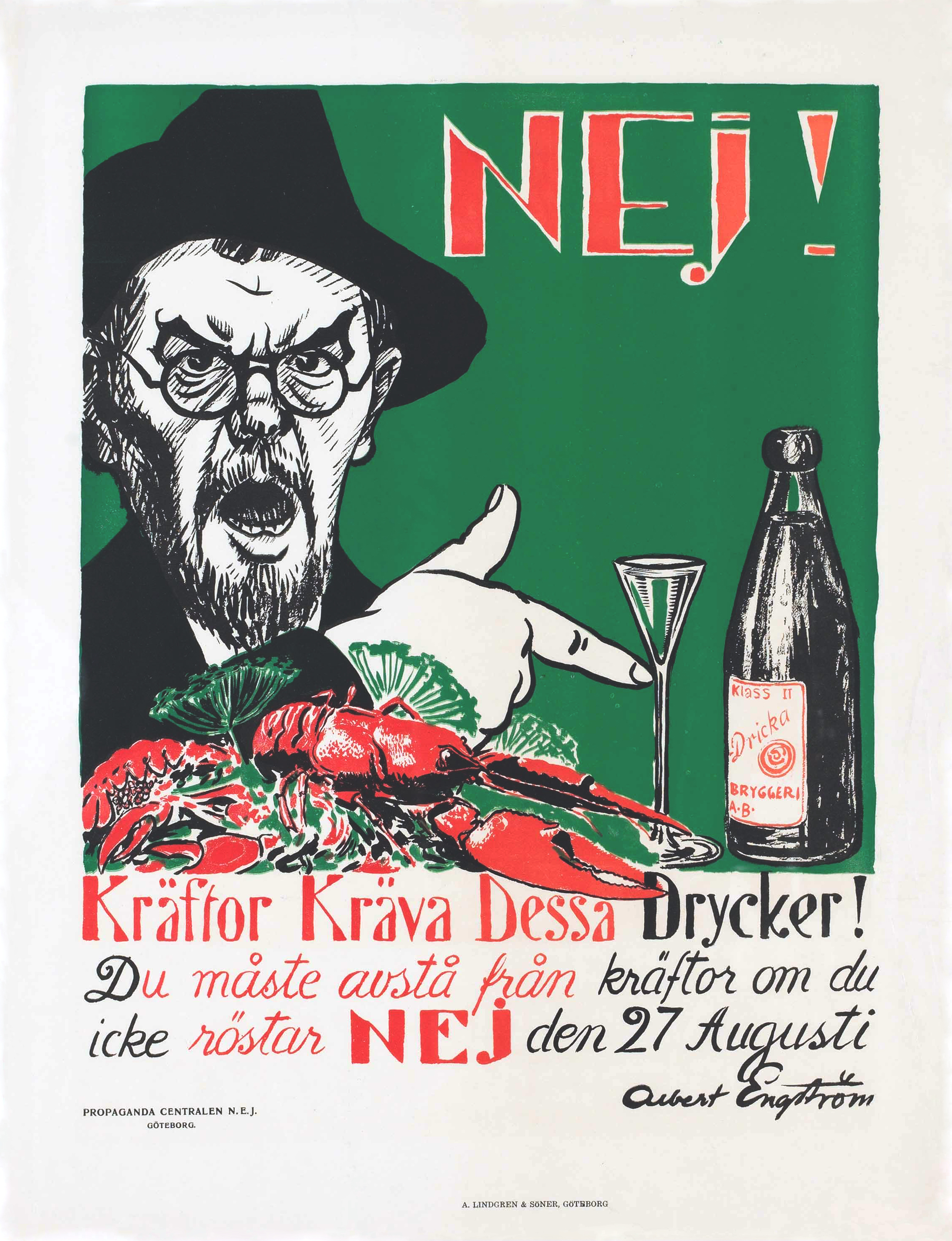
On top of that, the No campaign argued with the general liberty to do as one wants, the danger of a police and informer state, and of being forced to smuggle and distill in secret.





Voter turnout on 27 August 1922 was 55.1%. That may not sound like much, but it was more than in the previous general election.
The result was close and surprising: the opponents of prohibition won with 50.8% against 48.8%. Women, who had only been allowed to vote in Sweden since 1919, had overwhelmingly voted in favor of alcohol prohibition. But 59% of the men who voted against the ban had prevented the female vote from taking alcohol away from men. Thus probably narrowly avoiding an uprising and a civil war.
Sadly, there was no special quota in the ration book for celebrating the outcome of the referendum. Because, although the complete ban on alcohol had been averted, the restrictive alcohol policy remained in place. Rationing and the stamp book were not abolished until 1955.

And to this day, Swedes and visitors to Sweden live with another Scandinavian peculiarity: the state monopoly on alcohol sale. The monopoly has become somewhat spotty due to European Union law, but the general rule is that you can only get alcohol in a restaurant (at exorbitant prices) or in a state-run liquor store (at steep prices).
“Systembolaget” is the name of the state-run stores, which you won’t find on every corner.
Because the idea behind the Swedish model of a free country which is at the same time concerned about the welfare of its citizens is this: If you really want to get drunk, fine, that’s up to you. There are no more quantity restrictions. Likewise, there are no restrictions on alcohol content. You can even buy Stroh rum with 80% alcohol at Systembolaget. (I use this rum to let the raisins soak up alcohol, preferably for several days, before baking Kaiserschmarrn. My Kaiserschmarrn is very popular.)
But first you have to find a Systembolaget. For this, you have to drive up to 20 km, in the far north sometimes 100 km. The idea behind it: You should not get alcohol at the corner shop spontaneously, out of boredom or in a state of despair. If you have to squeeze yourself into a snowsuit, put on snowshoes and trudge 12 kilometers through deep snow before you get a beer, you might think twice and come to the conclusion that a hot chocolate is quite nice, too.
Because there are so few stores, you also have to wait in long lines. Again, the idea is to enable you to change your mind while you’re waiting and to buy chewing gum instead.
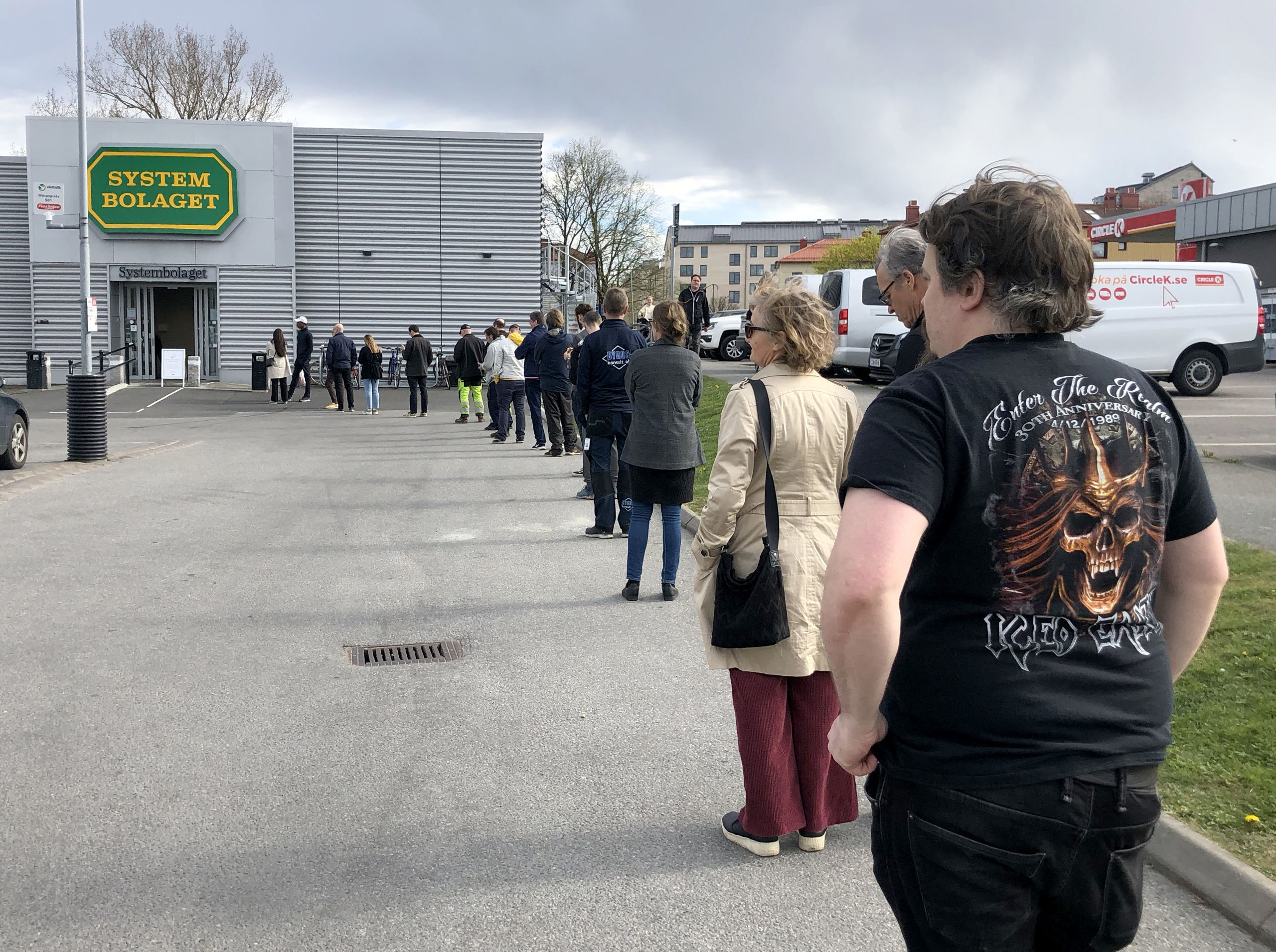
You also have to be at least 20 years old, which is strictly controlled. Anyone who makes a tipsy impression will not be served. I once smiled at someone in a Systembolaget and was expelled from the store because it was misunderstood as an indication of intoxication. I had walked 10 km for nothing.
Opening hours are extremely restrictive. On weekdays until 8 pm, on Saturday until 3 pm, and on Sundays and holidays the system is closed altogether. If the family freaks you out over Christmas in such a way that you need an urgent drink, you are lost. Or you have to take the ferry to Tallinn or Travemünde.
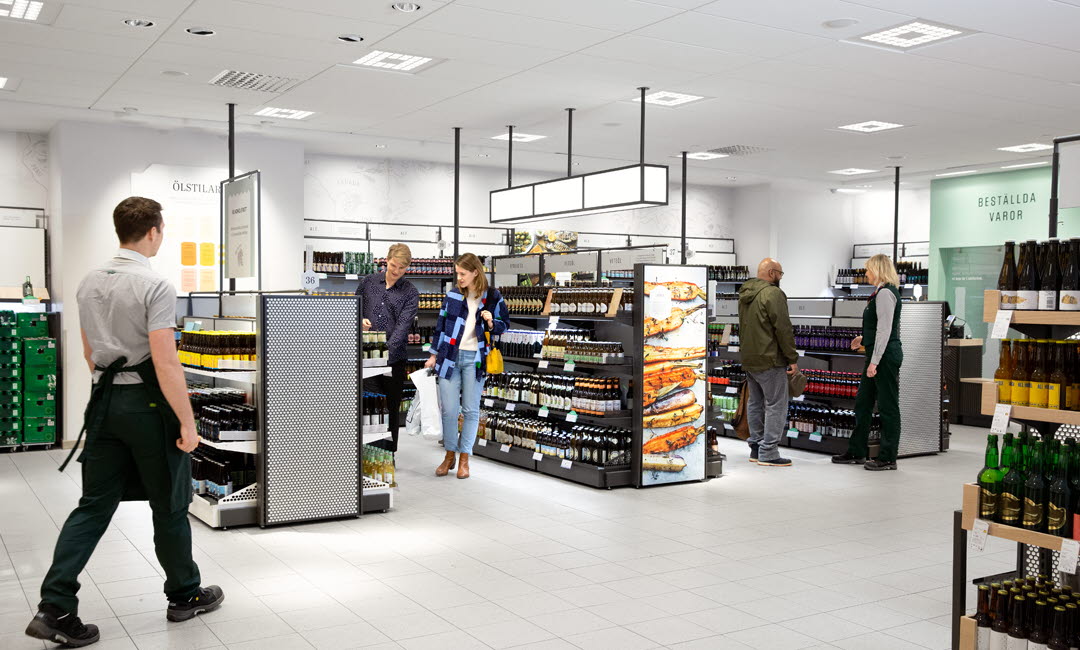
The stores are large, bright, well-stocked, with staff giving excellent advice. But there is nothing that would provide undue purchasing incentives: No bulk discounts. No six-packs, because then you might buy more than you actually wanted. Each can or bottle is sold individually. No shopping carts, so as not to buy too much. No chilled drinks, because that might tempt you to quickly finish the drink while it’s still cold. No “special offers” right before the checkout. No marketing consultants who want to create a “customer experience.”
It’s actually quite pleasant to be shopping in a store where no one is out to take as much money from you as possible. Where you are treated as a citizen, not as a customer.
So, what about the prices?
Honestly, I don’t think they’re that bad.
It’s true, alcohol is more expensive in Sweden than in Central, Southern or Eastern Europe. But everywhere in Scandinavia, everything is more expensive than elsewhere. Compared to the exorbitant prices of Swedish trains, I don’t find €2 for a bottle of beer a prohibitive price. In addition, taxes are set according to the alcohol content, but at a fixed rate rather than a percentage. For vodka (40% alcohol), for example, the tax is 20 €/liter. Granted, that’s a lot. But for wine (14% alcohol), the tax is €2.20 per liter. With the cheapest wine, that will make a difference, but if the bottle costs €50 anyway, then the tax hardly matters.
Just have a look at Systembolaget’s website. The prices are of course in Swedish krona, you have to divide them by 10 to get the euro/dollar price.
I really don’t understand the whining of the tourists. Especially not if they have previously bought a motorhome for €60,000 for the trip to Sweden. I think this exaggerated obsession about saving a buck says more about the (mostly German) tourists than about the Swedes.
And: Beer with less than 3.5% alcohol (so-called “folköl”, or people’s beer) can be bought in any supermarket. From the age of 18. Light beer (up to 2.25% alcohol) can even be bought by children.

And now I am curious to hear about your experience with alcohol in Scandinavia!
Links:
- All articles of the series “One Hundred Years Ago …”.
- More history.
- Further reports from Sweden.
- More stories about alcohol and the Systembolaget website.

Another interesting story. I’m afraid I don’t have any stories about alcohol and Scandinavia. But I enjoy Nordic Noir novels: Fossum, Kepler, Nesbo, Mankell, Sveistrup, Theorin. I must look into the Inspector Beck novels.
The turnout and result of the referendum seem to parallel the Brexit one in the UK. The Swedish one was clearly non-binding in theory and practice though, whereas the Brexit one was (I think) only non-binding until the results were announced.
I checked the prices on the Systembolaget website. I was totally shocked – so expensive. 50 EUR for a liter of Stella Artois! And then I realized that was Krona. Phew, 5 EUR/liter, that’s better. I don’t drink so I can’t really say much, but that seems OK. Unless you want to drink 10 liters of course.
Interesting they sell alcohol-free. Imagine driving 100 km through the forest just to get an alkoholfri öl.
Oh, these 10 novels by Sjöwall/Wahlöö are fantastic! But I would read them in the proper order, because the characters develop over time.
They are clever books, and beginning with the 3rd or so volume, they also become quite funny.
I used to be a fan of direct democracy, because I thought it would increase civic involvement and foster debate.
But now, I think there are subjects that are fit for it (like alcohol, maybe) and those that are not (untangling a country from a supranational organisation, which is also a customs union, a free-trade bloc and a space of free movement). But I don’t have a good theoretical approach to draw an exact line between the two.
Maybe the alcohol-free beer is a consolation prize, if you are deemed unfit to purchase alcohol? Or when you forgot your ID card.
Will definitely look into them. Have you read the inspector Kurt Wallander series by Mankell? Excellent, and also need to be read in order.
I haven’t read those yet.
Hopefully, I will get invited back to a house-sit in Sweden, so I can sit by a lake and read novel after novel again.
Soon you’ll be able to write a 100-years-later piece on Per Wahllöö. Sure to be more interesting than the history of ebriated Swedes.
That’s a very wide interpretation of the word “soon”.
Still lots of other stuff to cover between now and August 1926. Although August 1926 itself seems to have been a slow month, at least on cursory glance.